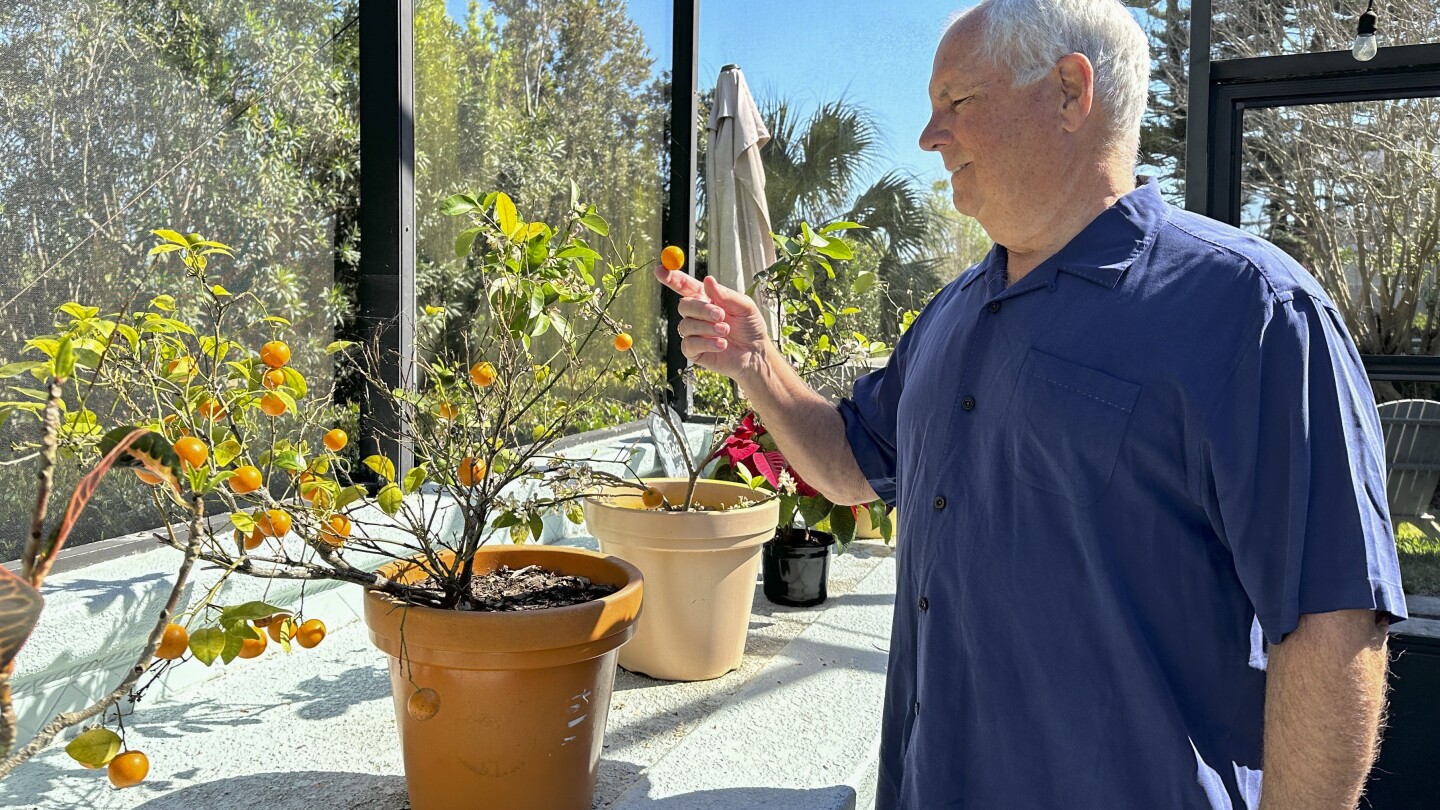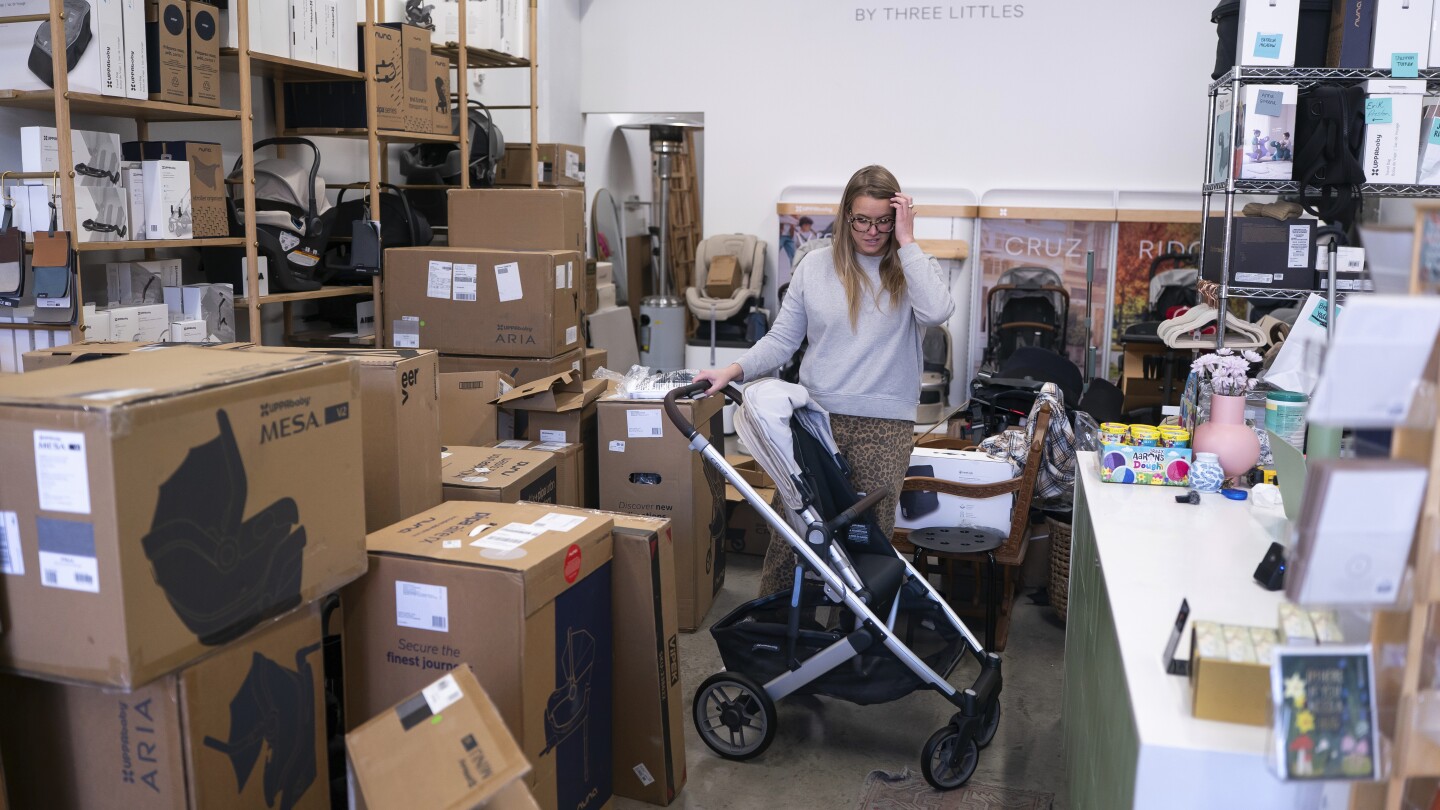Lifestyle
How a touristy Florida beach town became a top US remote work hub

ST. AUGUSTINE, Fla. (AP) — Lori Matthias and her husband had tired of Atlanta traffic when they moved to St. Augustine, Florida, in 2023. For Mike Waldron and his wife, moving from the Boston area in 2020 to a place that bills itself as “the nation’s oldest city” was motivated by a desire to be closer to their adult children.
They were among thousands of white-collar, remote workers who migrated to the St. Augustine area in recent years, transforming the touristy beach town into one of the top remote work hubs in the United States.
Matthias fell in love with St. Augustine’s small town feeling, trading the hour-long commute she had in Atlanta for bumping into friends and acquaintances while running errands.
“The whole pace here is slower and I’m attracted to that,” said Matthias, who does sales and marketing for a power tool company. “My commute is like 30 steps from my kitchen to my office. It’s just different. It’s just relaxed and friendly.”
Centuries before becoming a remote work hub, the St. Augustine area was claimed by the Spanish crown in the early 16th century after explorer Juan Ponce de Leon’s arrival. In modern times, it is best known for its Spanish architecture of terra cotta roofs and arched doorways, tourist-carrying trollies, a historic fort, an alligator farm, lighthouses and a shipwreck museum.
A population boom driven by the pandemic
In St. Johns County, home to St. Augustine, the percentage of workers who did their jobs from home nearly tripled from 8.6% in 2018 to almost 24% in 2023, moving the northeast Florida county into the top ranks of U.S. counties with the largest share of people working remotely, according to U.S. Census Bureau figures.
Only counties with a heavy presence of tech, finance and government workers in metro Washington, Atlanta, Austin, Charlotte and Dallas, as well as two counties in North Carolina’s Research Triangle, had a larger share of their workforce working from home. But these were counties much more populous than the 335,000 residents in St. Johns County, which has grown by more than a fifth during this decade.
Scott Maynard, a vice president of economic development for the county’s chamber of commerce, attributes the initial influx of new residents to Florida’s lifting of COVID-19 restrictions in businesses and schools in the fall of 2020 while much of the country remained locked down.
“A lot of people were relocating here from the Northeast, the Midwest and California so that their children could get back to a face-to-face education,” Maynard said. “That brought in a tremendous number of people who had the ability to work remotely and wanted their children back in a face-to-face school situation.”
Public schools in St. Johns County are among the best in Florida, according to an annual report card by the state Department of Education.
Surging popularity comes at a price
The influx of new residents has brought growing pains, particularly when it comes to affordable housing since many of the new, remote workers moving into the area are wealthier than locals and able to outbid them on homes, officials said.
Many essential workers such as police officers, firefighters and teachers have been forced to commute from outside St. Johns County because of rising housing costs. The median home price grew from $405,000 in 2019 to almost $535,000 in 2023, according to Census Bureau figures, making the purchase of a home further out of reach for the county’s essential workers.
Essential workers would need to earn at least $180,000 annually to afford the median price of a home in St. Johns County, but a teacher has an average salary of around $48,000 and a law enforcement officer earns around $58,000 on average, according to an analysis by the local chamber of commerce.
“What happened was a lot of the people, especially coming in from up North, were able to sell their homes for such a high value and come here and just pay cash since this seemed affordable to them,” said Aliyah Meyer, an economic researcher at the chamber of commerce. “So it kind of inflated the market and put a bit of a constraint on the local residents.”
Waldron, a sales executive in the health care industry, was able to sell his Boston home at the height of the pandemic and purchase a three-bedroom, two-bath home in a gated community by a golf course outside St. Augustine where “things really worked out to be less expensive down here.”
The flexibility offered by fast wireless internet and the popularity of online meeting platforms since the start of the pandemic also helped.
“If I was still locked in an office, I would not have been able to move down here,” Waldron said.
___
Follow Mike Schneider on the social platform Bluesky: @mikeysid.bsky.social
Lifestyle
Queen Elizabeth II’s favorite dog breed race for glory in the UK’s Corgi Derby

LONDON (AP) — Some of the fastest canines on four very short legs have raced for glory in Scotland’s annual Corgi Derby.
The Musselburgh Racecourse Corgi Derby was first held in 2022 to mark Queen Elizabeth II’s 70 years on the throne. The late monarch was a devoted corgi fan who owned almost 30 of the breed over the decades, along with a few dorgis – a corgi-dachshund cross.
Four-year-old Juno beat a 16-strong field of dashing dogs dressed in bright sweaters over the 230-foot (70-meter) race on Saturday at the racecourse outside Edinburgh. She came from behind in the final stretch to beat last year’s winner, Rodney.
The winner and her owners, Alisdair Tew and Fran Brandon, were presented with a trophy and dog treats by tennis coach Judy Murray, mother of Scottish star Andy Murray.
Tew told the BBC that “we trained her for this last year but this year we just resorted to just letting her chasing things, particularly seagulls” on Edinburgh’s Portobello Beach.
“Juno is always ready for treats -– that is probably why she won,” he said.
Elizabeth’s love of corgis began in 1933 when her father, King George VI, brought home a Pembroke Welsh corgi they named Dookie
Corgis were often by Elizabeth’s side in the decades before her death in September 2022 — accompanying her on official tours, reportedly sleeping in their own room at Buckingham Palace and occasionally nipping the ankles of visitors or royal family members.
Three corgis even appeared alongside the queen as she climbed into James Bond’s waiting helicopter in the spoof video that opened the 2012 London Olympics.
Lifestyle
Tariffs are likely to make having a baby cost more

Sam Rutledge and his wife have a baby due in mid-July, so they thought they had a few more months to research and buy the gear they’ll need.
But President Donald Trump’s tariff announcement in early April turned the couple’s slow walk into a sprint. In the past few weeks, they’ve bought two strollers, a car seat, a nursery glider, a crib and a high chair. All of them are made overseas.
“These are all pretty expensive under normal conditions, but when it became clear tariffs were coming we decided to buy them in case they became prohibitively expensive,” said Rutledge, who is a high school physics teacher.
Raising a child in America has never been cheap. In the first year alone, it costs an average of $20,384, according to Baby Center, a parenting website. But tariffs – ranging from 10% for imports from most countries to 145% for imports from China — will make it many times more expensive for new parents.
An estimated 90% of the core baby care products and the parts that go into making baby paraphernalia – from bottles and diaper pails to strollers and car seats – are made in Asia, according to the Juvenile Products Manufacturers Association, a U.S. trade group. The vast majority come from China.
“Overseas manufacturing has been the norm in our industry for decades,” said Lisa Trofe, the association’s executive director.
It wasn’t always this way. When Munchkin Inc. CEO Steven Dunn founded his company in 1991, it made baby bottles in California with tooling from New Jersey. But over the years, the manufacturers he used shut down and the cost of doing business in the U.S. skyrocketed. Now, about 60% of Munchkin’s 500 products, from a $5 sippy cup to a $254 Night Owl Stroller with headlights, are made in China.
In response to the tariffs, Dunn halted orders from China and instituted a hiring freeze at Munchkin’s California headquarters, where 320 people are employed. Dunn expects Munchkin will run out of some products within three months.
“There is no possibility of being able to pass on those tariffs” to customers in the form of price increases, he said.
Dunn said he tried to reduce his dependence on China in recent years, shifting some manufacturing to Vietnam and Mexico. He also spent a year communicating with American manufacturers to see if one could make Munchkin’s new Flow Nipple Shield, which allows a breastfeeding mother to see if her milk is flowing. But most said they couldn’t make the complex silicone product, Dunn said. It’s now made in Vietnam.
“There’s not enough tool makers and manufacturing expertise and automation and skilled labor in the U.S. to make the thousands of products the juvenile industry needs,” Dunn said.
Multiple baby brands and companies contacted by The Associated Press didn’t respond or said they weren’t commenting on the tariffs, including Graco, Chicco, Britax, Nuna, Dorel Juvenile, UppaBaby, Evenflo and Bugaboo.
The Juvenile Products Manufacturers Association said it asked the Trump administration for a tariff exemption, arguing that baby products are essential for children’s well-being. Trump exempted some baby products, including car seats and high chairs, from import taxes during his first administration. But he hasn’t said whether he would consider doing so again.
The Associated Press left a message seeking comment with the White House.
Nurture&, a company that makes a popular nursery glider and other baby furniture, said it’s trying to be transparent about the impact of tariffs.
In a recent email, the company told customers it started lowering prices on some items when the tariffs hit. The company, which was founded in 2020, said it would keep those lower prices in place until April 30, but after that it may not be able to absorb the full cost of the import duties.
“These are large purchases, these are investments, and this is a very sensitive life stage,” Nurture& Chief Merchant Jill Gruys said. “We want people to make the best decision for their budget and their family.”
Elizabeth Mahon, the owner of Three Littles, a baby store in Washington, said she’s worried the tariffs will make essential products too expensive for some families.
Mahon volunteers twice per month at the Department of Motor Vehicles, where she teaches people how to buckle their kids safely into car seats. Some families still must be persuaded to use car seats, she said. Mahon fears higher prices would be another deterrent.
“No one is dying if they can’t buy a toy, but if they don’t have access to car seats, kids will get seriously injured,” she said.
At her own store, Mahon is getting notices that some manufacturers plan to introduce steep price increases in May. She feels lucky she could rent a storage facility and build up inventory ahead of the tariffs. For many small businesses, she said, the extra costs are “a death sentence.”
At The Little Seedling baby shop in Ann Arbor, Michigan, owner Molly Ging said she would normally be putting in Christmas orders at this time of year. Instead, she’s sorting through price increase notices from many of the vendors she works with.
“It’s a lot to manage, and I just have no idea how it’s going to play out,” she said.
Business is brisk right now, with customers hoping to beat tariff-related price increases. But Ging worries about her 13 employees – all moms who bring their kids to work – and about whether she can maintain enough inventory to meet future demand.
“Babies don’t stop being born because there’s tariffs,” she said.
Lifestyle
Famed Sherpa guide will attempt to climb Mount Everest for a 31st time and break his own record

KATHMANDU, Nepal (AP) — One of the greatest mountain guides will attempt to scale the world’s highest peak for the 31st time — and possibly the 32nd time as well — and break his own record.
Kami Rita, 55, flew to Mount Everest on Sunday from Kathmandu to lead a group of climbers who will try to reach the 8,849-meter (29,032-foot) summit during the spring climbing season.
“I am mentally, emotionally and physically prepared to climb the mountain,” Kami Rita told The Associated Press at Kathmandu’s airport. “I am in my top physical condition right now.”
He holds the record for the most successful ascents of Mount Everest at 30 times. In May last year he climbed the peak twice.
“My first priority is to get my client to the summit of the peak. Then I will decide on whether I will climb the peak more than one time during the season. It depends on the weather and conditions on the mountain,” he said.
His closest competitor for the most climbs of Mount Everest is fellow Sherpa guide Pasang Dawa, who has made 27 successful ascents of the mountain.
Kami Rita first climbed Everest in 1994 and has been making the trip nearly every year since. He is one of many Sherpa guides whose expertise and skills are vital to the safety and success each year of foreign climbers aspiring to stand on top of the mountain.
His father was among the first Sherpa mountain guides. In addition to his Everest climbs, Kami Rita has scaled several other peaks that are among the world’s highest, including K2, Cho Oyu, Manaslu and Lhotse.
According to Nepal’s Department of Tourism, 214 climbers have been issued permits to attempt Mount Everest from the Nepali side of the peak in the south this climbing season, which ends in May. Most climbing of Everest and nearby Himalayan peaks is done in April and May, when weather conditions are most favorable.
Everest was first climbed in 1953 by New Zealander Edmund Hillary and Nepali Sherpa Tenzing Norgay.
-

 Education2 days ago
Education2 days agoHarvard’s battle with the Trump administration is creating a thorny financial situation
-

 Europe2 days ago
Europe2 days agoTrump’s ‘lone ranger’: How Steve Witkoff became the defacto point man on America’s foreign policy challenges
-

 Conflict Zones2 days ago
Conflict Zones2 days agoIran has ‘doubts’ about US intentions ahead of nuclear talks | Politics News
-

 Conflict Zones2 days ago
Conflict Zones2 days ago‘How do I live like this?’ asks Gaza boy who lost arms in Israeli attack | Gaza News
-

 Conflict Zones2 days ago
Conflict Zones2 days agoTrump says US may ‘pass’ on helping end war if Russia, Ukraine resist deal | Russia-Ukraine war News
-

 Middle East1 day ago
Middle East1 day agoTunisian court hands opposition figures lengthy jail terms | Human Rights News
-

 Sports2 days ago
Sports2 days agoClint Dempsey speaks to CNN over his concerns over the USMNT heading into its home World Cup
-
Europe2 days ago
Italy cable car: Four people killed, one injured as car plunges into a ravine




